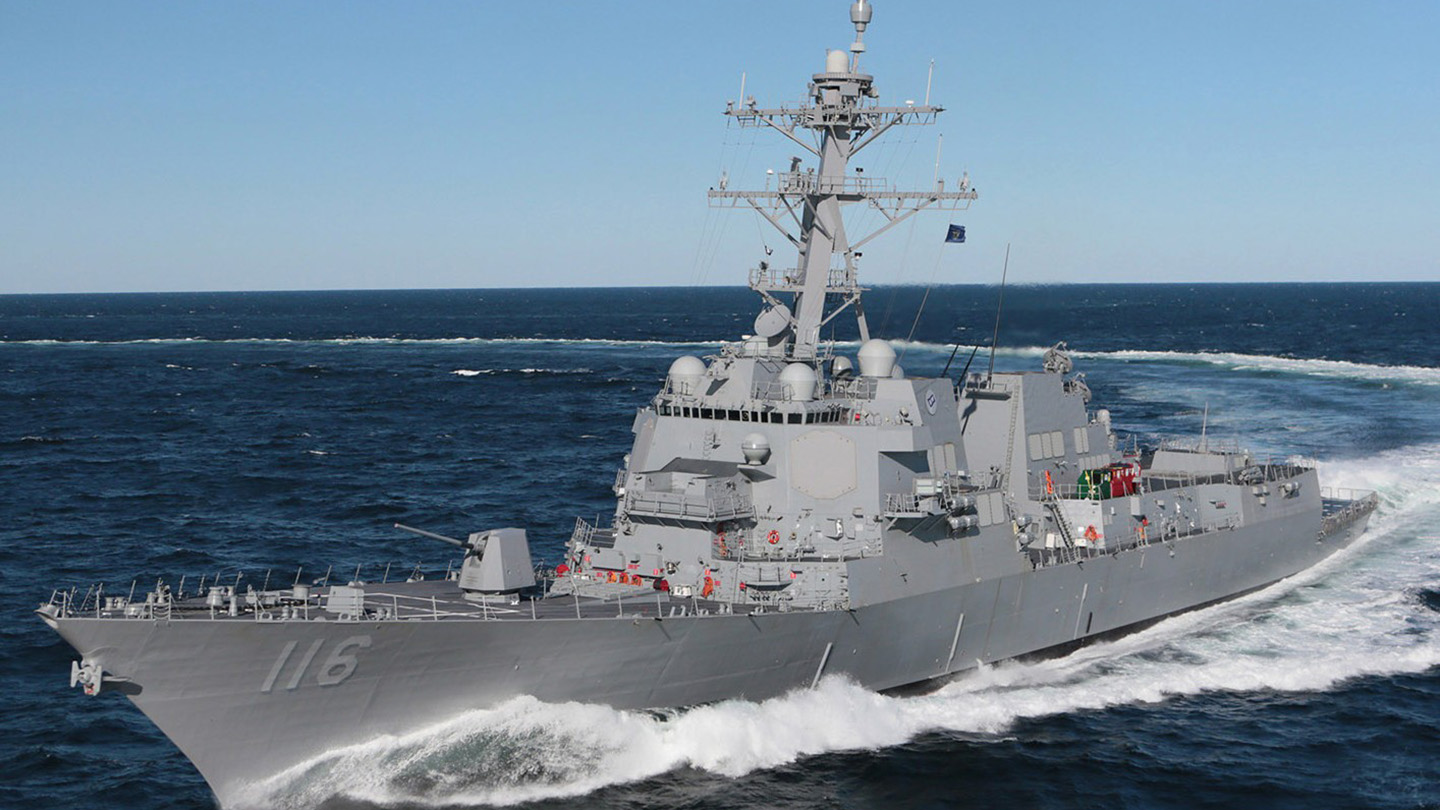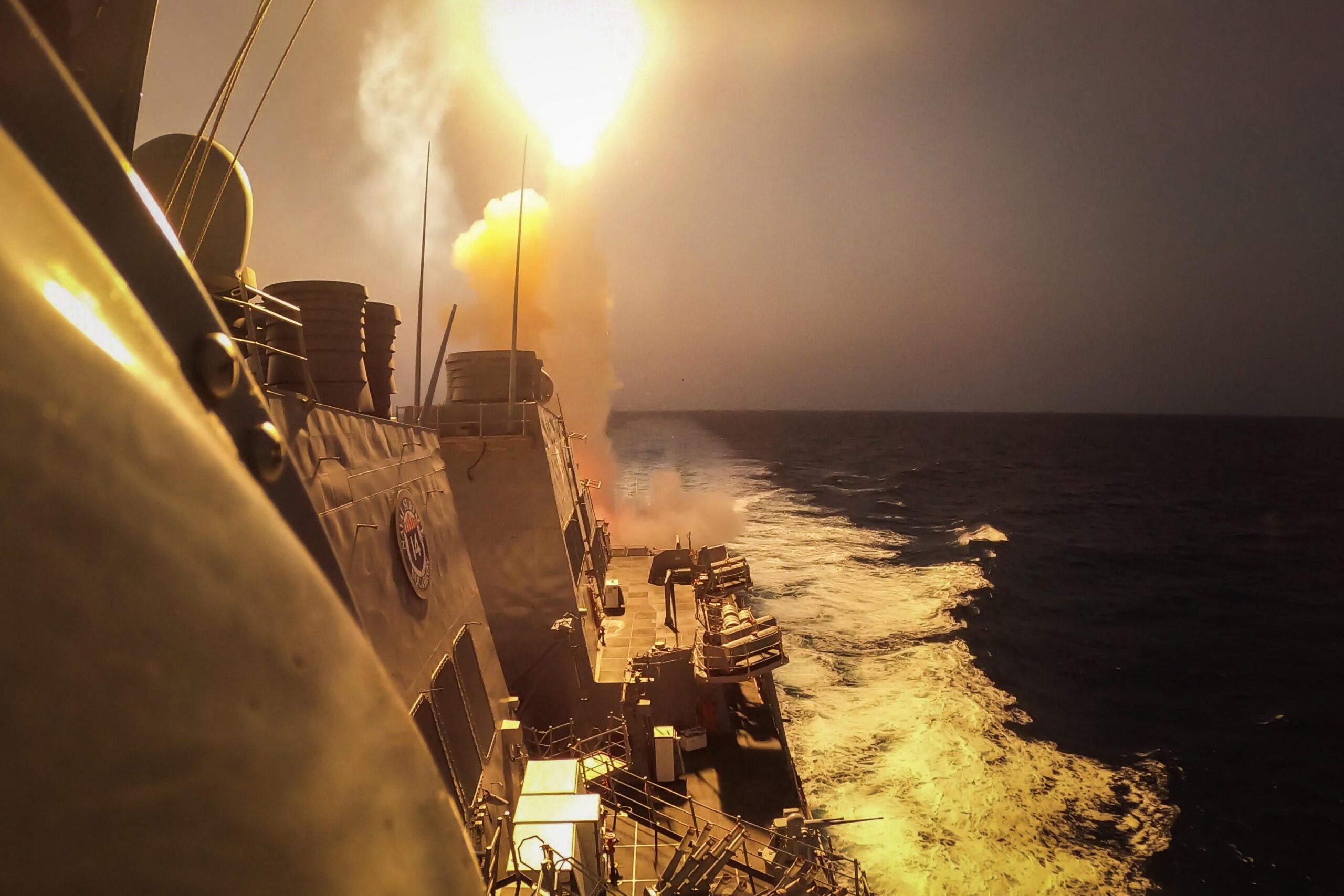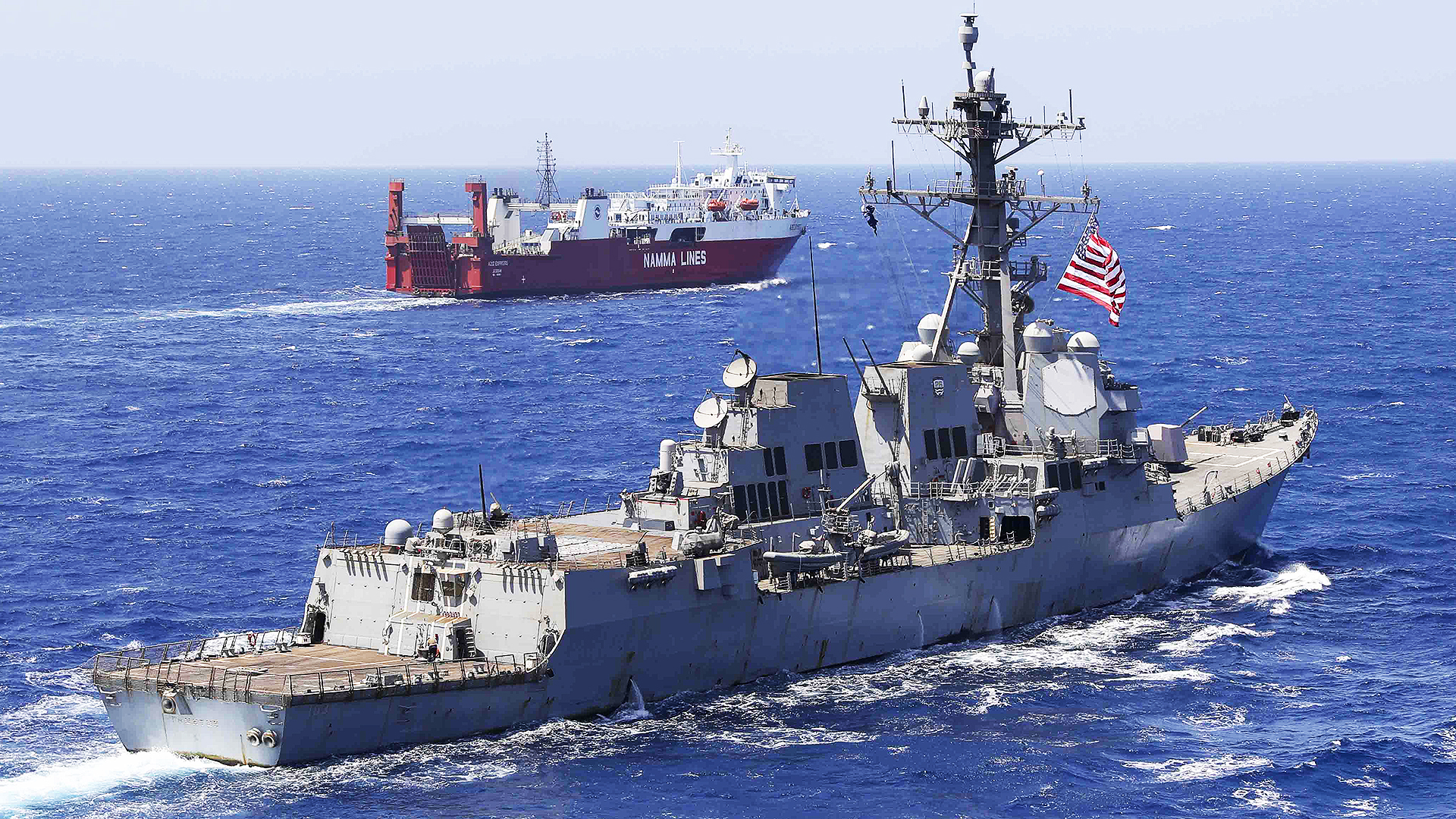Operation Prosperity Guardian (OPG), the newly formed international coalition to protect commercial shipping from Houthi attacks, will be akin to a highway patrol on the Red Sea, the Pentagon’s top spokesman said Thursday. The coalition was formed in response to scores of attacks on vessels that began in the wake of the Israel-Hamas war.
“It’s very important to understand that Houthis aren’t attacking just one country, they’re really attacking the international community,” Air Force Maj. Gen. Pat Ryder told reporters, including from The War Zone. “They are attacking the economic well-being and prosperity of nations around the world. So in effect, they’ve really become bandits along the international highway that is the Red Sea. The forces assigned to Operation Prosperity Guardian will serve as a highway patrol of sorts, patrolling the Red Sea and the Gulf of Aden to respond to and assist as necessary commercial vessels that are transiting this vital international waterway.”

Those forces now include representatives of more than 20 nations, Ryder announced Thursday, adding that Greece and Australia have joined the initial 10 nations that publicly acknowledged their participation during Defense Secretary Lloyd Austin’s visit to the region earlier this week. However, Australia is only sending 11 military personnel while Greece is sending an as-yet-unnamed frigate, its defense minister announced.
Beyond ships, OPG will have an aviation component, Ryder said, confirming what we previously suggested.
“I’m not going to go into the specifics in terms of which capabilities are or which assets per se, but yes, air will be a part of this, especially when it comes to maritime domain awareness,” he said. “Air power is always a significant contributor to that.”
From our story first raising that possibility: “Land-based aircraft, such as U.S. Navy P-8A Poseidon maritime patrol aircraft and MQ-9 Reaper drones, could also support Operation Prosperity Guardian from various bases in the region. The Houthis notably shot down a U.S. MQ-9 operating over the Red Sea back in November.” There are many other types of aerial assets that will likely be included, as well, from rotary wing types to other countries’ fixed wing patrol aircraft, and even tactical jets operating from land bases and the USS Dwight D. Eisenhower.
Who’s In?
Ryder declined to offer further details about how OPG – under the command of Combined Maritime Forces (CMF) Task Force 153 – will work or the number of U.S. ships that will take part.
There are already several in the region. In addition to the Eisenhower carrier strike group, Arleigh Burke class guided missile destroyers USS Carney, USS Mason and USS Hudner have been in the Red Sea and shot down Houthi missiles and drones in the past month. In addition, the Arleigh Burke class guided-missile destroyer USS Laboon recently transited the Suez Canal to deploy to 5th Fleet, which covers the Arabian Gulf, Gulf of Oman, North Arabian Sea, Gulf of Aden, and the Red Sea.
Maritime expert John Konrad, who runs the gCaptain news site, said the “U.S. Navy says they don’t have enough warships to start” OPG. Responding to a question about that from The War Zone, Ryder disagreed.
The U.S. military has “the ability to surge capabilities to where we need them to address situations around the globe and the U.S. Central Command Area of Responsibility is no different,” he said. “And so as we require capabilities, we have a very long-standing process in place by which to determine requirements, make decisions, and then surge forces into the theater. And so this will be no different in that sense.”
A U.K. MoD spokesman told us Thursday that while the HMS Diamond will be the only warship it is contributing specifically to OPG, it has several others in the region, including HMS Lancaster, HMS Chiddingfold, HMS Middleton, HMS Bangor and RFA Cardigan Bay.

“The presence of the other ships you list will continue to contribute to maritime security in the region, which complements the work being done under Op PG,” the spokesman told us on condition of anonymity to discuss operational details.
Italy has sent the Bergamini/FREMM class frigate Virginio Fasan to the Red Sea to protect shipping, but it is not part of OPG, Reuters reported.
France’s Aquitaine-class frigate Languedoc is in the Red Sea and shot down a drone launched by the Yemeni militant group earlier this month. It will not operate, however, under the command of OPG, Reuters reported.

Ryder on Thursday would not comment on why Bahrain was the only Arab nation to publicly join OPG. As we discussed in a previous story, while the Saudis have a huge stake in what happens in the Red Sea, they are both trying to end a long and costly conflict with the Houthis and mend fences with regional rival Iran.
Egypt, which owns the Suez Canal, also has a major interest in the success of OPG, with nearly $10B a year in revenue earned from canal operations.
It remains whether either of those nations are involved in OPG, however.

China, meanwhile, appears to have no interest in joining OPG.
“The Red Sea is an important international trade route for goods and energy. Safeguarding the security and stability of the region serves the common interest of the international community,” China’s Foreign Affairs Ministry spokesman Wang Wenbin said during a press conference Thursday. “China stands for protecting the safety of international sea lanes and against causing disturbance to civilian ships. We believe relevant parties, especially major countries with influence, need to play a constructive and responsible role in keeping the shipping lanes safe in the Red Sea.”
Wang’s reference to “major countries with influence” reflects Beijing’s recognition that the U.S. and its allies and partners can muster, at speed, far greater naval power necessary for a seaborne shipping protection campaign than Beijing currently can, Politico suggested.
While that may be one take, the idea that China would pick a fight with the Houthis – a proxy of Iran — just to participate in a U.S.-led operation, especially when others are doing it for them, and own the fallout that comes from it, doesn’t seem to fit their playbook in any way.
Houthi Threats
The Houthis have been making it clear since The War Zone first broke the news about OPG that they see it as a threat. On Thursday, they released a video extolling their naval assets.
On Wednesday Houthi leader Abdul-Malik al-Houthi directly threatened the U.S.
“Any American targeting of our country will be targeted by us, and we will make American battleships, interests, and navigation a target for our missiles, drones, and military operations,” al-Houthi said Wednesday in a televised broadcast.
Ryder declined comment when asked by The War Zone about those threats.
Despite al-Houthi’s bellicose statement, there have been no reported attacks on Red Sea shipping since Dec. 18, when there were Houthi strikes on two vessels.
Still, there have been over 100 Houthi drone and ballistic missile attacks, targeting 12 merchant, the Pentagon said. As a result, the U.S. is “discussing all kinds of different strike packages against the Houthis, including radar facilities and installations,” a U.S. military official told The War Zone Thursday.
It’s part of a much wider review of how to respond to ongoing attacks on U.S. facilities in Syria and Iraq, said the official, speaking on condition of anonymity to discuss operational details. There have now been more than 100 strikes against U.S. facilities in those two countries since Oct. 17, the Pentagon says.
The official would not say when those strikes would occur or what assets would be used.
“I’m not going to telegraph, forecast, or speculate on any type of kinetic action,” Ryder said Thursday when asked by The War Zone about any plans to attack the Houthis.
How OPG Could Work
The decision to create OPG “is a smart one and a proven approach,” Joseph Votel, a retired Army general who ran CENTCOM from 2016 to 2019, told The War Zone.
“We have successfully employed Maritime Task Forces for specific purposes in the Middle East (and elsewhere) for decades,” said Votel, now a distinguished senior fellow at the Middle East Institute. “I think this force will hopefully give the shipping industry confidence that they can transit this critical waterway safely. OPG will bring not only defensive capability but also offensive tools in the event we decide we need to strike back at Houthi positions and capabilities that threaten the free flow of commerce through the Red Sea.”
Traditionally, such an operation would be executed via the use of convoys, where warships can protect groups of shipping vessels transiting the high risk area under their defensive umbrellas. Convoy duty sounds fairly simple, but it’s a resource intensive mission few want to execute. You can read more about that here. On the other hand, having ships protect zones along the route that ships pass through could be another strategy. While this sort of ‘picket’ defense may be a more attractive option, depending on the assets available, it may look more free-form and undulating than what some may think.
Speaking from his experience as former CENTCOM commander, Votel said he expects the positioning of OPG’s maritime assets “at locations that allow them to collect and respond to multiple threats coming from Houthi-controlled Yemen – missiles, UAVs, boats, helos, mines, etc.”

“Think of this as more of a ‘network’ security approach versus stationary pickets or dedicated escorts,” he said. “My view is that escorting individual ships is not particularly economical and frankly, unnecessary, given modern-day sensor-shooter capabilities and sophisticated communications systems.”
Likewise, “stationary pickets are vulnerable and predictable and I would expect the Houthis to quickly figure out options to get around these positions. I would imagine these military vessels would be very mobile and use their speed and maneuverability to continue to operate from locations that provide the best opportunity to detect and defeat a variety of threats.”
“An important aspect to appreciate here is the collective command, control and communication systems that allow better sharing of information and situational awareness and which paints a more complete picture of ‘picture’ of what is happening in the Red Sea waters. This is something that has been developed over the last number years that the Combined Maritime Force has been in existence.”

Regardless of how OPG works, Votel argues that the U.S. needs to be prepared to hit the Houthis.
“My personal view is that we have to be prepared to strike at the Houthi positions and capabilities that are perpetrating these attacks,” he said. “And, we need to do it in a decisive way that leaves no room for ambiguity or uncertainty.”
It’s a matter of global economics.
“The impact of shipping being diverted around the Red Sea is significant and we cannot afford to have a group like the Houthis disrupting the fundamental of free-flowing commerce, which is one of our primary National Security Interests.
However, while “the military component is critically important, we should also be pulling out all the stops informationally, diplomatically and economically to make sure the Houthis and their sponsors, Iran, feel the full consequences of their actions. In other words, we need to leverage all means available to stop this behavior.”
Earlier in the day, we reported that the shipping industry has many questions about how OPG will operate.
“I think what the international community shipping wants to understand timeframes,” Joshua Hutchinson, Managing Director of Risk and Intelligence for the Ambrey maritime security firm told us. “Where will these assets be based? How long before they get there? What areas are they covering? What’s their reaching capability? And I think that’s the kind of stuff that we that the industry will need.”
To highlight the concerns, he shared with us a chilling radio transmission from one of the ships that came under Houthi attack, which you can listen to below.

How this ‘maritime highway patrol’ comes together and ultimately works, if it does at all, still remains to be seen. The notable public absence of major regional players like Saudi Arabia, Egypt and United Arab Emirates, as well as the reluctance of key allies like Australia to provide vessels raises concerns about the viability of OPG.
It is still early in the process though and this coalition of the willing has doubled in size, at least in terms of countries participating in some manner, since first announced. We will continue to watch as it develops and provide updates when warranted.
Contact the author: howard@thewarzone.com
